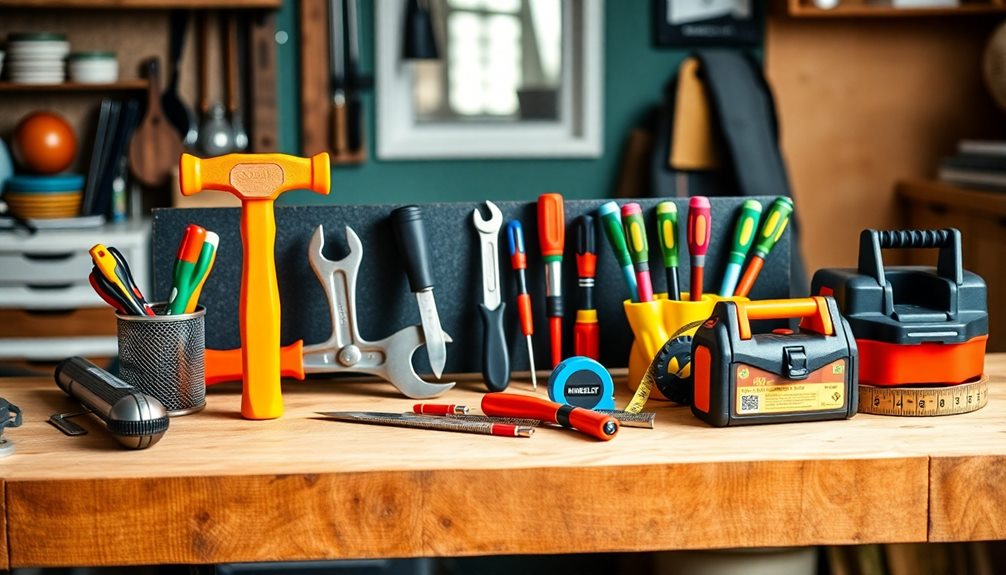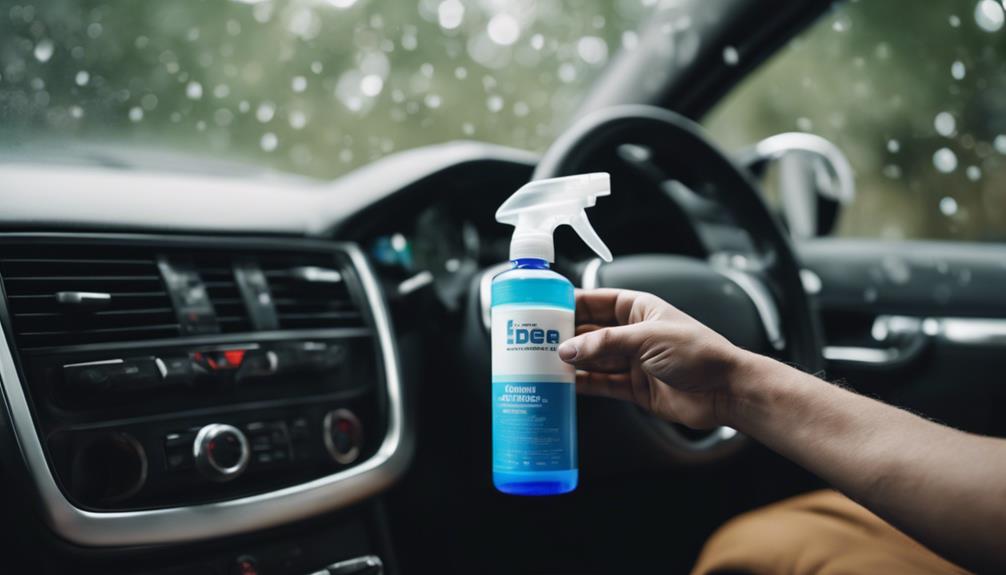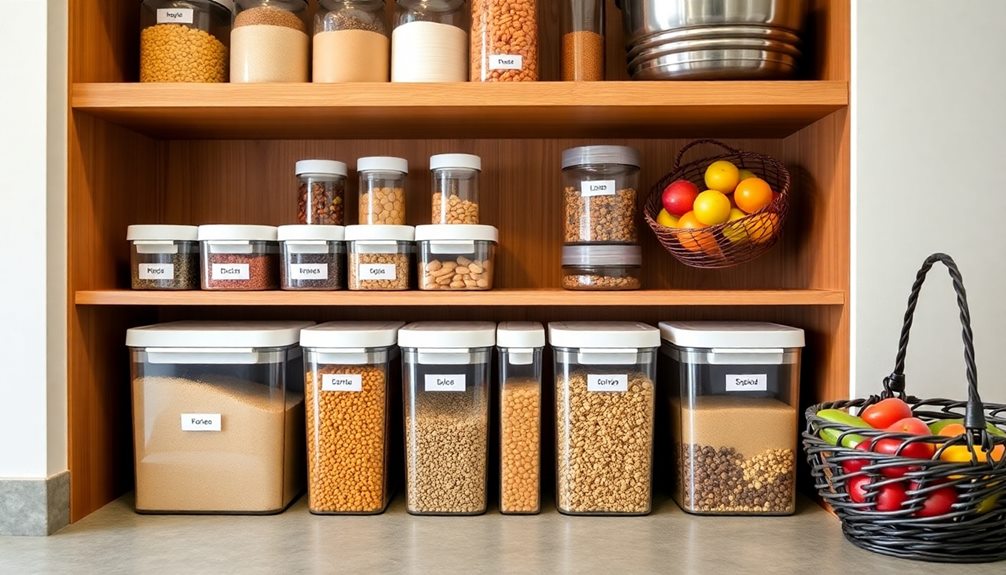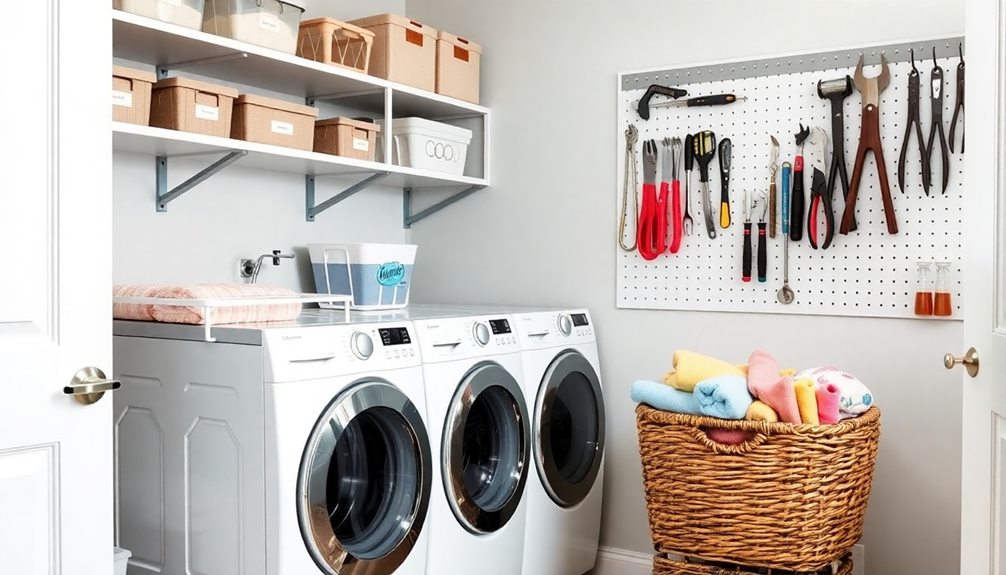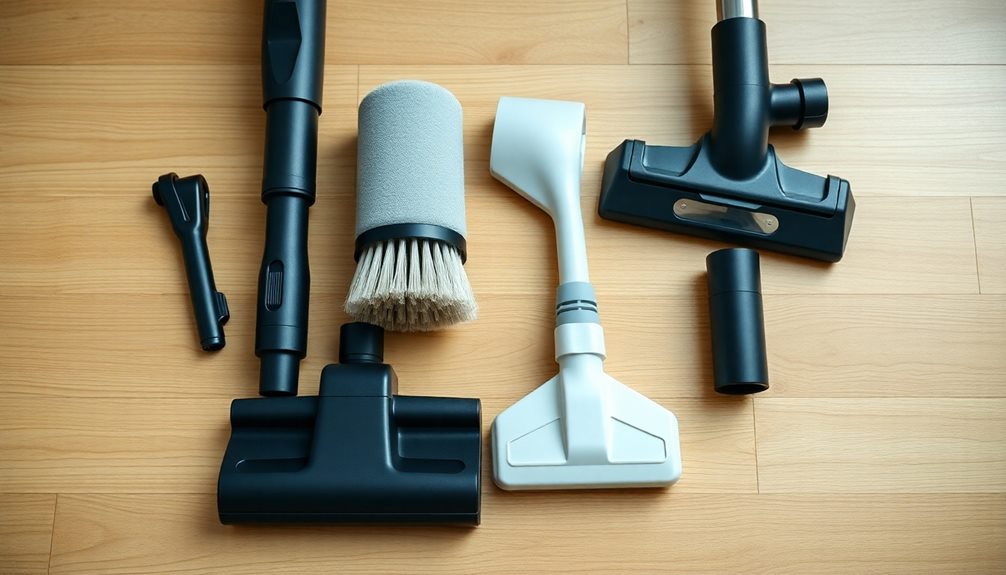Every home needs a solid toolkit for tackling repairs and projects. Start with essential hand tools like a claw hammer, a set of pliers, and a 25-foot tape measure. Include power tools such as a cordless drill and a circular saw to make tasks easier. Don't forget safety gear like goggles and gloves to keep yourself protected. Organizing your tools with a toolbox or magnetic dishes makes finding what you need fast and easy. With these must-have items, you'll be ready for almost any task around the house. Keep going to discover even more handy tools to improve your toolkit!
Key Takeaways
- A claw hammer is essential for driving nails and light demolition tasks around the home.
- A versatile set of pliers, including needle-nose and wire-cutting types, is crucial for various gripping and cutting needs.
- A 25-foot tape measure ensures accurate measurements, helping to avoid costly mistakes in projects.
- A cordless drill significantly speeds up home projects, making it a must-have for drilling and driving screws efficiently.
- Proper safety gear, including goggles and gloves, is vital to protect yourself while working with tools and materials.
Essential Hand Tools
When assembling your home toolkit, including essential hand tools is crucial for tackling a variety of tasks. Start with a quality claw hammer, which is perfect for driving nails and handling light demolition. A medium-weight hammer can also serve most household applications effectively.
Next, you'll want a set of pliers—consider including needle-nose, grooved, wire-cutting, and vise-grip types. Each offers unique versatility for gripping, twisting, and cutting tasks.
Don't forget a reliable tape measure, ideally around 25 feet, for accurate measurements that help you avoid costly mistakes. For those times when you need to tighten or loosen bolts, an adjustable wrench will be indispensable.
Additionally, stocking up on various nails and screws guarantees you're prepared for hanging items and securing furniture. A well-rounded toolkit should include these essential tools alongside screwdriver bits, allowing you to tackle different screw types with ease.
Ultimately, investing in a solid set of tool kits with these hand tools will empower you to handle a wide range of home improvement projects efficiently and effectively.
Measurement Tools
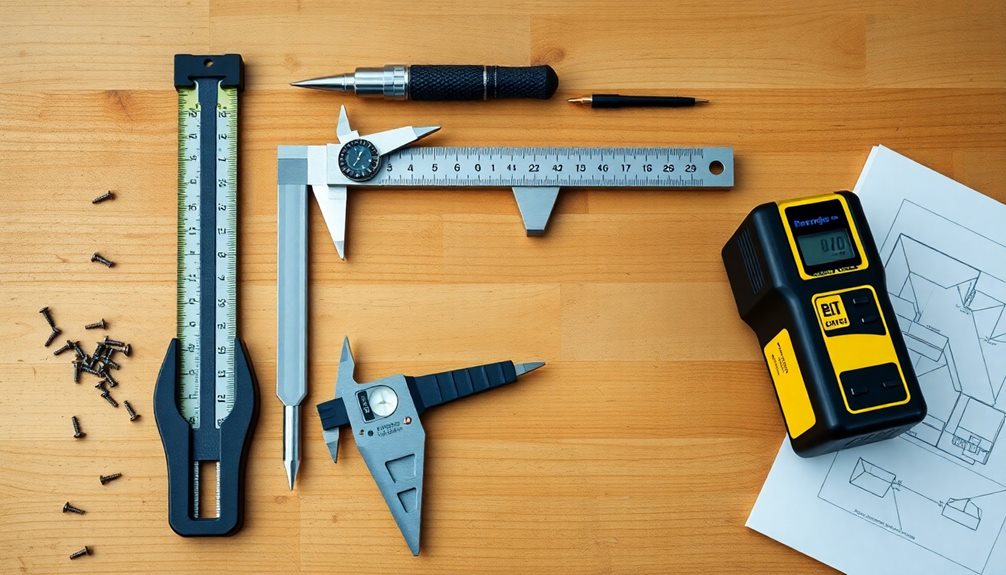
Accurate measurements are vital for any home project, as they can save you time and money.
You'll want to equip yourself with essential tools like tape measures, stud finders, and levels to guarantee precision.
With the right techniques, measuring can become a quick and easy part of your DIY routine.
Importance of Accurate Measurements
Getting precise measurements is vital for any home project, as even a small miscalculation can lead to costly mistakes like ill-fitting furniture or improperly installed fixtures.
When tackling home repairs or household tasks, having the right tools in your tool kit can make all the difference. A reliable tape measure is a must-have; a 25-foot version is ideal for most household use, allowing you to measure larger spaces with ease.
Using a level, such as the Stanley 48-Inch Box Beam Level, guarantees your installations are straight and even, as it offers an impressive accuracy of ±0.0005 inches. This level of precision not only enhances your work but also boosts your confidence in the results.
Additionally, a stud finder is essential for locating wall studs before hanging heavy items. This tool prevents damage to walls and guarantees secure anchoring for safety.
Essential Measurement Tools
Having the right measurement tools is key to achieving success in your home projects. To guarantee accurate measurements and avoid costly mistakes, equip your home repair tool kit with these essentials:
| Tool | Purpose |
|---|---|
| Tape Measure | Ideal for measuring spaces; a 25-foot length works for most projects. |
| Levels | Guarantees precise alignment; a Stanley 48-Inch Box Beam Level is accurate to ±0.0005 inches, perfect for hanging pictures and cabinets. |
| Stud Finder | Locates wooden and metal studs to prevent damage when hanging heavy items. |
| Carpenter's Squares | Checks right angles and guarantees precise cuts in woodworking. |
| Chalk Line Tool | Creates straight lines over long distances for accurate marking. |
Each of these tools plays a vital role in your projects. A tape measure gives you the length you need, while levels guarantee everything's straight. The stud finder helps you hang items securely, and carpenter's squares assure precision. Don't forget the chalk line tool for long, straight lines. With these essential measurement tools, you're well on your way to completing your home projects successfully!
Tips for Effective Measuring
Effective measuring is vital for the success of any home project, so mastering a few key techniques can make a notable difference. Start by investing in a reliable tape measure, like a 25-foot Stanley Fatmax, to guarantee accurate measurements and prevent costly mistakes. When measuring, always double-check your figures to avoid errors.
For projects that require heating or cooling adjustments, consider using tools that help assess the efficiency of your systems, as energy-efficient heat pumps can greatly impact your overall home comfort and energy bills.
Use a stud finder to locate wood and metal studs behind walls. This tool is essential for securely anchoring heavy items and preventing damage during installation.
A level, such as the Stanley 48-Inch Box Beam Level, is another must-have; it helps you achieve straight lines and even surfaces with incredible precision.
Incorporate a carpenter's square in your toolkit to assist with marking and cutting right angles, making it invaluable for woodworking and construction projects.
Power Tools
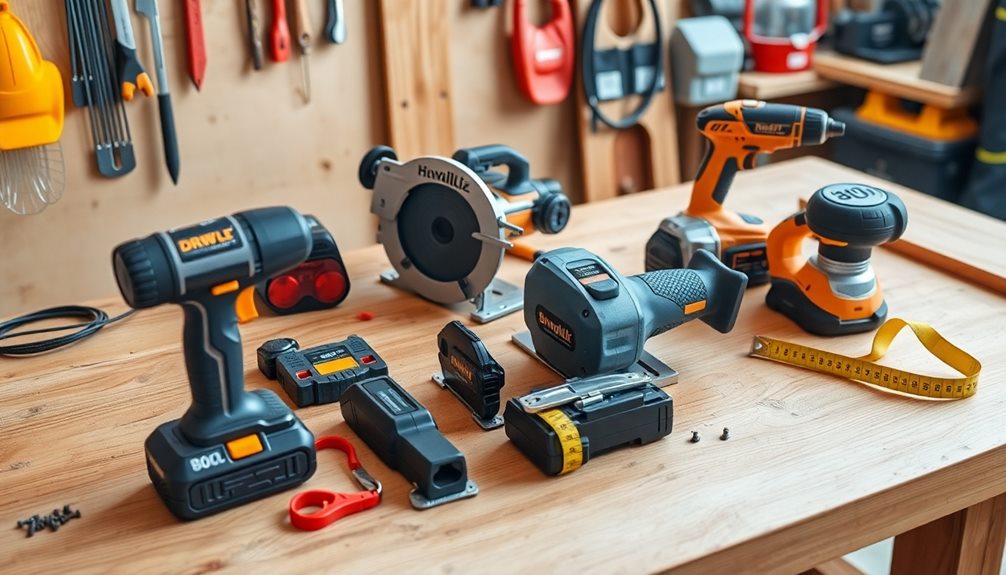
When it comes to tackling home projects, having the right power tools can make all the difference. A cordless drill, for instance, is vital for drilling and driving with ease, while safety gear guarantees you stay protected during your work.
Let's explore some essential power tools that will elevate your toolkit and enhance your DIY experience.
Essential Power Tools
In any DIY project or home renovation, having the right power tools can make all the difference in efficiency and quality. A cordless drill is your go-to for making holes and driving screws efficiently. Consider models like the DeWalt 20V Max, which costs around $99 and works with over 200 DeWalt tools.
If you're tackling tougher materials, an impact driver will provide the extra torque you need to drive screws quickly and effectively.
For cutting wood and other materials, a circular saw is vital. It allows you to make straight cuts swiftly, perfecting your projects.
When it comes to finishing touches, a sander—whether palm or orbital—is essential for smoothing surfaces before painting, ensuring a professional look.
Lastly, a jigsaw is invaluable for making intricate and curved cuts, adding detail to your woodworking tasks.
Together, these essential power tools can transform your DIY project and home renovation efforts, making the process smoother and results more satisfying. Equip yourself with these tools, and you'll be ready to tackle any home improvement challenge!
Cordless Drill Importance
A cordless drill stands out as one of the most versatile power tools in your toolkit, essential for speeding up a variety of home projects. Whether you're making holes or driving screws, this tool considerably outperforms manual methods.
For instance, the DeWalt 20V Max cordless drill offers high torque and a 1/2-inch chuck, accommodating larger bits for diverse tasks. Additionally, having a reliable tool like a cordless drill can enhance your home security setup, as proper installation of security devices is vital for effective monitoring and protection cost of home security systems.
With various voltage ratings available, you can choose a drill that meets your needs, from light DIY projects to heavy-duty applications. Higher voltage models provide the power you need for demanding jobs, making them invaluable in any home.
Many cordless drills come equipped with variable speed settings, allowing you to adjust the speed for different materials and tasks, enhancing your overall efficiency.
Additionally, rechargeable models eliminate the hassle of disposable batteries, making them a cost-effective and eco-friendly choice for homeowners. With features like LED lights for better visibility in dark spaces, a cordless drill truly becomes one of your essential tools.
Investing in this power tool won't only simplify your home projects but also elevate your DIY experience to new heights.
Safety Gear Necessity
Safety gear is your first line of defense against potential hazards while using power tools. Without it, you risk serious injuries from flying debris and excessive noise.
Start with high-quality safety goggles, like HDX Safety Goggles, priced at just $5. These will protect your eyes from dust and harmful particles that can cause lasting damage. Regular maintenance of your tools can also enhance their performance and safety, as noted in effective preventive maintenance strategies.
Next, don't forget gloves. They're essential for safeguarding your hands from cuts and abrasions, ensuring you maintain a firm grip on your tools and materials.
When using loud power tools, ear protection is vital; prolonged exposure to high decibel levels can lead to permanent hearing loss.
Additionally, consider wearing dust masks or respirators during tasks like sanding, cutting, or grinding. These protect your respiratory health by preventing inhalation of harmful particles.
Always prioritize your safety by equipping yourself with the right gear. It's not just about comfort; it's about ensuring your protection while you work on projects with tools.
Investing in proper safety gear is a smart move that can save you from accidents and health issues down the line. Stay safe and work smart!
Safety Gear
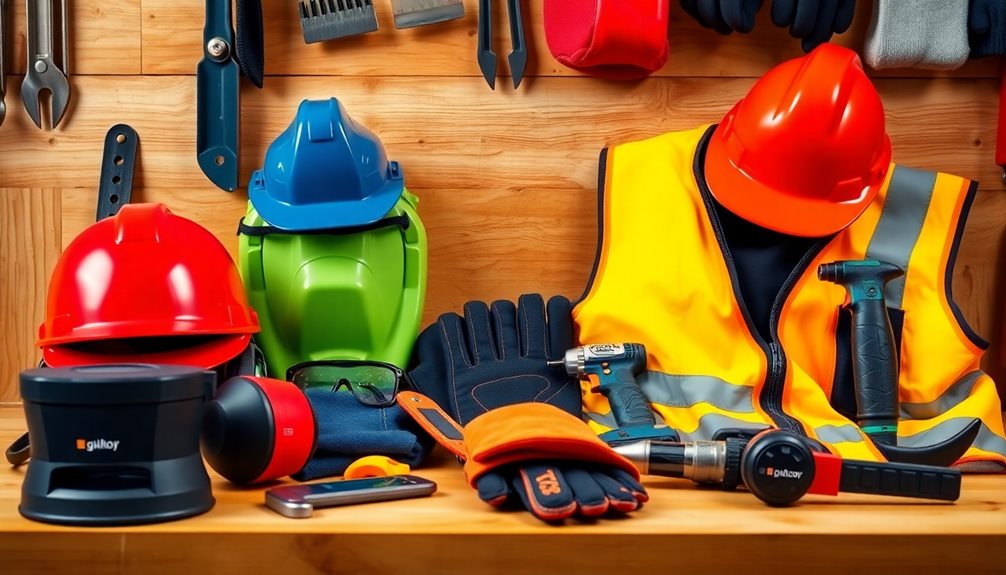
Protecting yourself during home repairs and DIY projects is vital to minimizing the risk of injury. Investing in safety gear is a smart choice that can keep you safe while you work.
One of the best options for eye protection is HDX Safety Goggles, which are priced at just $5. They effectively shield your eyes from debris and hazardous materials, making them a cost-effective investment.
Wearing gloves is another important aspect of safety gear; they help prevent cuts and scrapes. Opt for high-quality models that guarantee comfort and dexterity, allowing you to work efficiently without sacrificing safety.
When tackling projects that generate dust, don't forget to wear dust masks. These masks are essential for protecting your respiratory health, especially when sanding or working with materials that create particles in the air.
Tool Organization
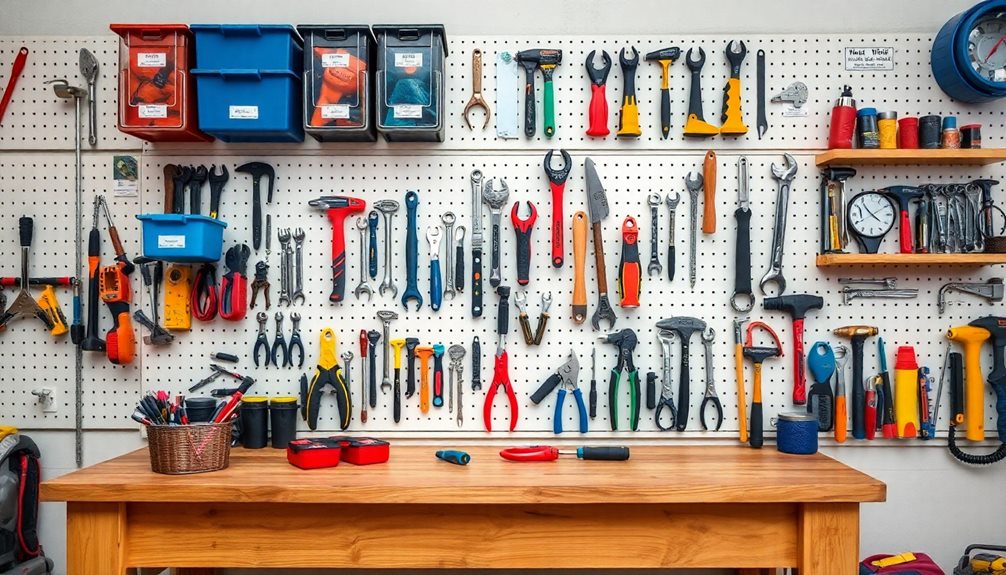
Once you've equipped yourself with the right safety gear, it's time to focus on how you manage your tools. Effective tool organization is essential for enhancing efficiency and keeping everything easy to find. Consider using a toolbox or bag with compartments, like the Harbor Freight Hercules Tool Tote with 22 pockets. This setup helps you maintain a systematic arrangement of your tool sets.
You can also use magnetic parts dishes to organize small hardware pieces, preventing loss during projects. Regular sorting and decluttering will help you identify items needing replacement or repair, ensuring your household tool kit remains functional. Implementing a labeling system for your storage solutions makes it even easier to access your tools, especially if your collection is large.
Here's a quick overview of some organizing strategies:
| Strategy | Benefits | Tools Needed |
|---|---|---|
| Toolbox with Pockets | Keeps tools organized | Toolbox or tool bag |
| Magnetic Dishes | Prevents loss of small parts | Magnetic parts dishes |
| Sorting & Decluttering | Identifies items for repair | None; just time and effort |
| Labeling System | Streamlines access | Labels or a label maker |
With these strategies, you'll optimize your tool organization for any project.
Specialty Tools
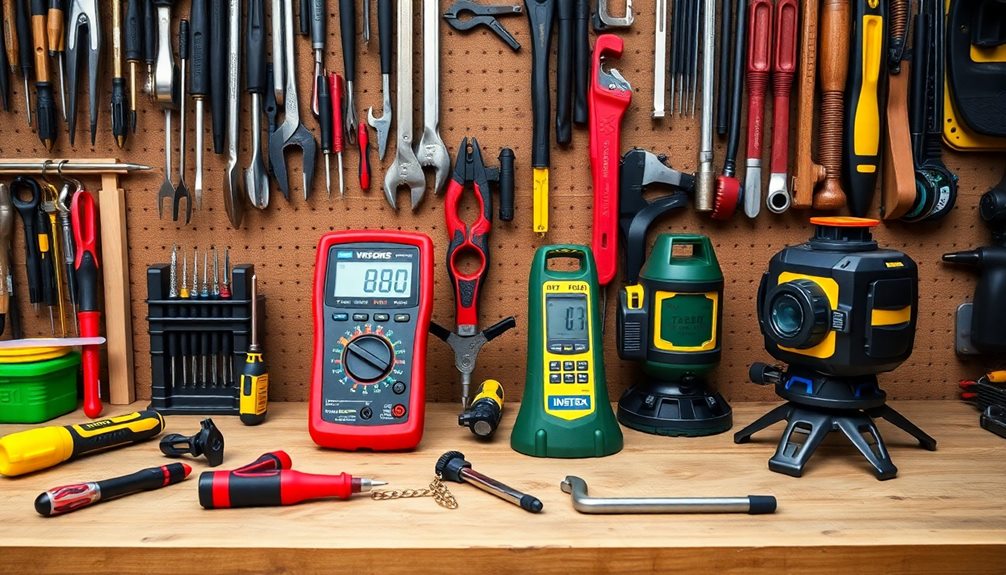
When tackling home improvement projects, specialty tools can make all the difference in achieving professional results.
These tools not only enhance your efficiency but also help you execute tasks with precision. Here are some must-have specialty tools for your toolkit:
- Stud Finders: Essential for accurately locating wall studs, preventing damage when hanging heavy items. A reliable model like Zircon is priced around $20.
- Utility Knife: The Milwaukee Fastback is a top choice, featuring a replaceable blade and one-handed operation for various cutting tasks, available for about $18.
- Rotary Tools: Versatile tools like the Dremel 4000-2/30 offer multiple attachments for intricate projects, priced around $90.
Additionally, don't overlook caulking tools, such as the Newborn Smooth Hex Rod Caulking Gun, which enhance precision while sealing gaps, promoting energy efficiency.
Touch-up markers like the Varathane Wood Touch-Up Marker Kit are also great for restoring furniture, costing only $10.
Maintenance Supplies
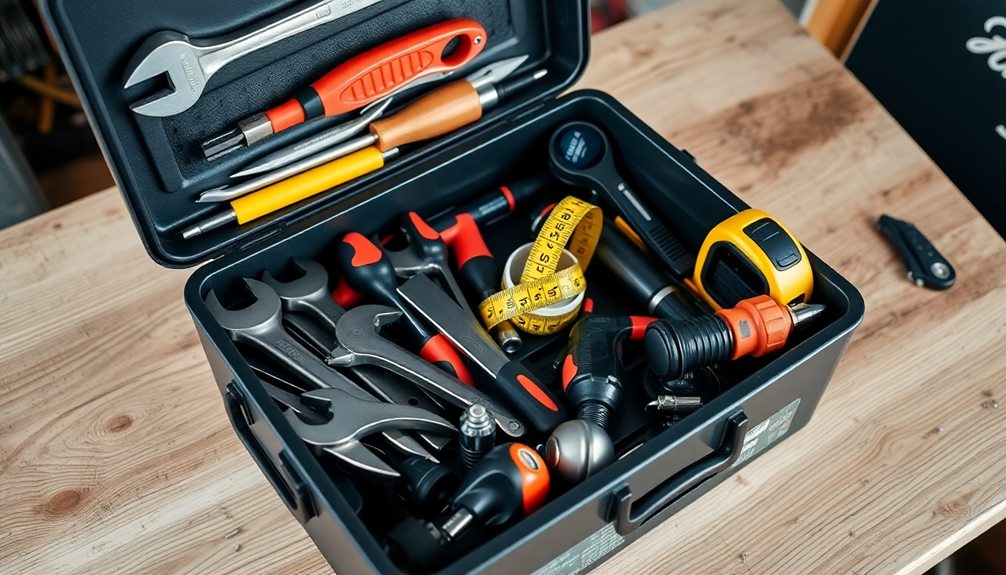
To keep your tools and workspace in top shape, having the right maintenance supplies is critical. A well-equipped toolbox helps you organize tools and prevent clutter. Stock up on important maintenance items like lubricants to guarantee tool longevity, and don't forget cleaning supplies such as brushes and rags to keep everything in prime condition.
Safety equipment is also essential. Use safety glasses, ear protection, dust masks, gloves, and knee pads to protect yourself during various tasks. Additionally, keeping batteries on hand for your cordless tools is a must. You don't want to find yourself stuck mid-project because of a dead battery.
Finally, maintaining a supply of nails and screws is crucial for various repairs and hanging projects. Here's a quick overview of these important maintenance supplies:
| Supply Type | Purpose | Importance |
|---|---|---|
| Lubricants | Enhance tool performance | Tool longevity |
| Cleaning Supplies | Keep tools in good condition | Prevent rust and wear |
| Safety Equipment | Protect against injuries | Guarantee safe maintenance |
With these supplies, your home projects will run smoothly and safely!
Frequently Asked Questions
What Should Everyone Have in Their Tool Box?
You should have a tape measure for precise measurements, a claw hammer for driving nails, various screwdrivers for different screws, pliers for gripping, and a stud finder for securely hanging items on walls.
What Are the Most Frequently Used Tools in Your Home?
A stitch in time saves nine; having a sturdy hammer, a reliable tape measure, versatile screwdrivers, and efficient pliers makes your home tasks easier. You'll find these tools indispensable for quick fixes and projects.
What Should a Toolkit Include?
A toolkit should include a claw hammer, various screwdrivers, pliers, an adjustable wrench, a tape measure, a utility knife, a stud finder, and safety gear. Keeping everything organized in a sturdy toolbox is essential for efficiency.
Why Does Every Household Need to Be Equipped With Basic Hand Tools?
Every household needs basic hand tools to tackle everyday repairs efficiently. You'll save time and money, avoid unnecessary calls to professionals, and guarantee your home remains safe and functional by being prepared for maintenance tasks.
Conclusion
In summary, having the right tools at your fingertips can save you time and prevent headaches down the line. Whether you're tackling simple repairs or starting on DIY projects, a well-stocked toolkit can make all the difference. Remember, it's better to be safe than sorry, so don't skimp on safety gear! Keep your tools organized and ready, and you'll be well-prepared to handle whatever home maintenance challenges come your way. Happy fixing!
